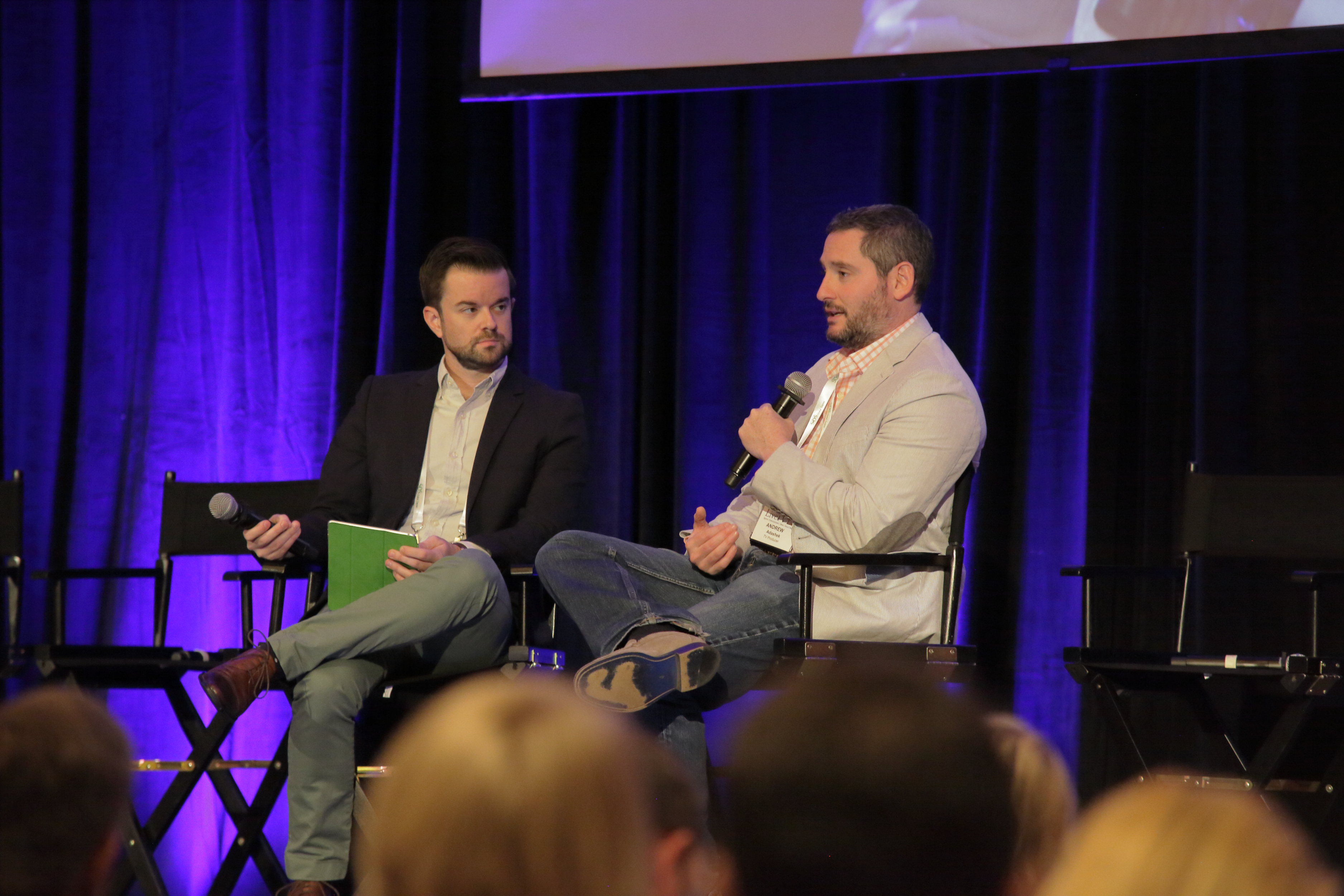LiveTV:LA: Keynoter Andrew Adashek Says Twitter’s NFL, NBA Deals Show Social Media’s Power for Live Production
Story Highlights
SVG’s third-annual LiveTV:LA event drew more than 400 live–television-production professionals to the Sheraton Universal Hotel in Los Angeles yesterday for a day of panels, technology exhibits, networking, and a pair of social-media–fueled keynotes: at noon by former head of Twitter Television Andrew Adashek, in the afternoon by Facebook’s Rob Shaw (global sports media partnerships) and Fox Sports’ Mark Pesavento (SVP, content production). New this year to the LiveTV:LA program was a Facebook Live Bootcamp, in which the Facebook team and other broadcasters that have found success on the platform offered tips and best practices.

Andrew Adashek (right) spoke on his experiences at Twitter, The Voice, and more during a keynote conversation with SVG’s Brandon Costa.
During the first keynote, Adashek, who led the TV team at Twitter for five years, spoke about his experiences at the social-media platform, his work as one of the first producers hired to launch The Voice in the U.S., and where he sees the industry headed. Among the myriad topics, he addressed the power of Twitter for live production.
“Twitter, at its core, is a live platform,” he said. “It’s real time, it’s public, it’s conversational. So, when you look at live television or live video or the Periscope acquisition from a platform standpoint, Twitter’s [greatest asset] is live. That is one of the core value propositions of Twitter, so it’s a natural fit [for major live productions].
The Promise of the NFL and NBA Deals
Adashek noted Twitter’s recent live-streaming deals with the NFL and NBA, in particular, as potential goldmines for what is to come for live events.
“One of the reasons the NFL deal came together — and there’s a lot of them — [is that] the content they were putting on the platform through the Amplify program at Twitter was incredibly engaging with younger demographics, whom the NFL needs to reach,” he said. “But I think, once you start to bring the conversation and the content closer, there’s so much more you can do with it. Right now, they’re pretty limited as to how they can clip the stream and what they can do with that content. But, when you think about how you now have much more specific audience data, I think it’s just the tip of the iceberg of what’s possible. But you have to reach that critical mass first before you can take that next big leap.”
Although Twitter’s NFL and NBA deals marked a turning point for the industry in terms of live streaming of major sports events, Adashek stressed that the long-term roadmap remains key.
“I think [Twitter live-content] deals with the NFL and the NBA are just the starting point,” he explained. “The question I have of the whole industry for live [content] is, if you start with the NFL and you draw an audience, what’s next? If you build an audience, you then have to nurture that audience and understand your audience and continue to work with them. So one might argue the reason TV networks pay so much money for sports is that it launches all their other shows. But, for Twitter and the major [social-media] platforms, the question becomes, ‘We have the NFL and the NBA, but what am I building towards? What are the bigger, longer-term pieces?’”
Social by Design
Prior to his time at Twitter, Adashek served as one of the first producers of The Voice on NBC. Arguably the most social-media–focused show currently on a broadcast network, The Voice constantly looks to integrate social media into the linear telecast and vice versa. However, he stressed that this multiplatform integration must be natural, not forced.
“We started to build shows at that point, five years ago, social by design,” he said. “It wasn’t just after the fact, taking clips and throwing them out there and hoping we had an audience. We were thinking about the story from a social perspective. So we were bringing in feedback in real time. We were bringing in all this content; we were pushing it out in real time based on what people were saying. We were working on integrating those pieces … because technology for technology’s sake is a waste. I have always said I’d rather have nothing on-air for Twitter or for social than something that doesn’t fit.”
In addition to integrating content between the linear telecast and social media, Adashek also spoke of the importance of feedback and metrics offered by the social-media sphere.
“If you’re keeping abreast of what’s happening on all these platforms, there are amazing stories being told about your shows when you’re not there,” he said. “If you tap into that, you’re tapping into not only a passionate fan base but people that are watching and talking about the show. And, if you can draw that in, it’s a whole opportunity of other people doing work for you.”
LiveTV:LA was made possible by sponsors All Mobile Video (title); Cast & Crew, Canon, Sony, and VER (Diamond); Clear-Com, Comrex, Hitachi, LiveU, Panasonic, PRG, Ross Video, Saunders Electric, The Studio – B&H (Gold); and 360 Designs, AJA, Aveco, Bitcentral, JVCKenwood, SOS Global, Telestream, Teradek, and Telescope.
